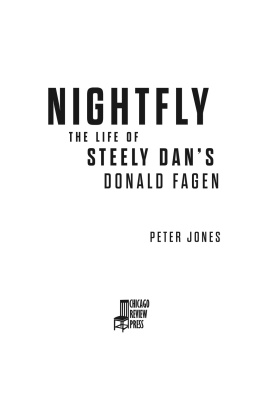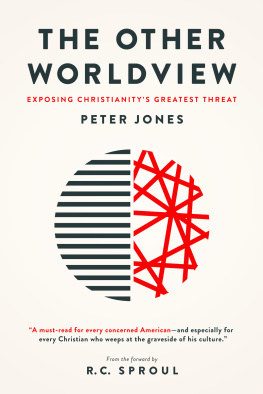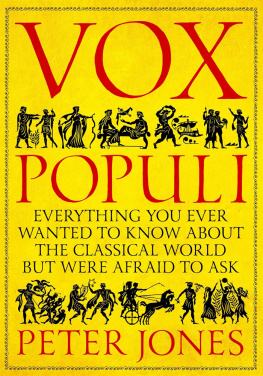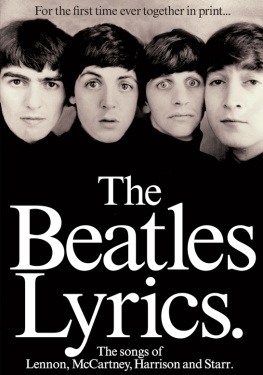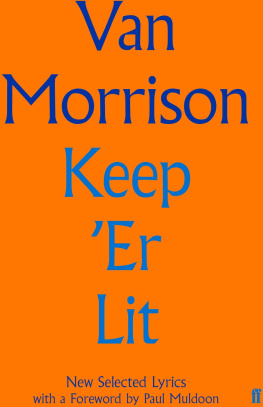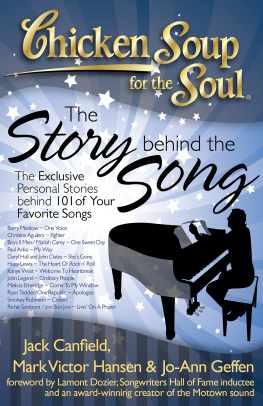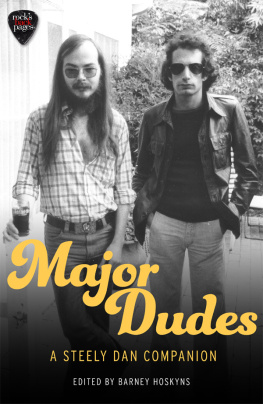I WOULD LIKE TO thank the following: Trevor Lever, for his help and creative input at every stage of this project; also Simon Carter, Kenny Vance, Ladd Vance, Audrey Thaler, Elliott Randall, Bill Schnee, Jay Willingham, Georg Wadenius, Jenny Soule, Krishna Das, Howard Rodman, Connie Reeder; and my agent Jane Graham-Maw, editors Kara Rota and Benjamin Krapohl, and Rebekah Slonim. The following books were invaluable sources: Brian Sweets seminal history Reelin In the Years (2nd ed., Omnibus Press, 2018), Aja by Don Breithaupt (Continuum, 2007), Steely Dan FAQ by Anthony Robustelli (Backbeat, 2017), Major Dudes edited by Barney Hoskyns (Constable, 2017), Dave DiMartinos Do It Again: The Steely Dan Years (Kindle e-book, 2009), and Donald Fagens own Eminent Hipsters (Vintage, 2014).
Numerous useful newspaper and magazine interviews were found in the Steely Dan Reader archive and on rocksbackpages.com. However, for any errors of fact, the responsibility is mine alone.
Introduction
D ONALD FAGEN will forever be associated with Steely Dan, the band he formed with Walter Becker and four other musicians in 1972. Few have enjoyed so much success with such varied and sophisticated music. The smooth, radio-friendly veneer of the duos songs made Steely Dan internationally popular and famous in the 1970s, but it masked underlying layers of anger, disappointment, sleaze, and often downright weirdness. The elliptical lyrics wereand continue to bean endless source of fascination, while the music defies categorization. In fact, from the earliest days, almost no one could describe it. Comparisons were attempted, whether with Frank Zappa or Poco, but these were always inadequate, sometimes verging on ludicrous. It is now clear that Fagen and Steely Dan were sui generis, their music painstakingly distilled from elements of rock, R&B, blues, soul, jazz, pop, country, funk, Brecht-Weill, Bach, and Stravinsky, along with the Henry Mancini faux-luxe TV themes that mesmerized Donald as a child. So thoroughly did he internalize these sources that his own music emerged as something entirely unique.
Of course he wasnt the first American Jew to craft something original from the materials he found around him. Many others with family roots in Jewish Eastern Europe had trodden the same path, from Irving Berlin to Randy Newman. But perhaps the most influential of them all, for Donald Fagen, was Bob Dylan, who came from the folk tradition while also borrowing freely from blues and country music. Jewish composers working in the orchestral/modern classical area, from Darius Milhaud to Philip Glass, were similarly magpie-like in their search for their own style among the ethnic crosscurrents of American life. In doing so, they created the American music of the twentieth century. Donald Fagen has earned his place alongside them.
Much has been made of his jazz influences. In fact, for many listeners, Fagens music served as their gateway drug to jazz. After all, who wouldnt want to investigate the source of all that gorgeous harmony, those complex and detailed arrangements? In an age of disappearing melody, [Fagen and Becker] seem more and more like the George and Ira Gershwin of the 70s, wrote one reviewer at the time of Steely Dans first reunion tour. Ground zero for them was not Buddy Holly or Elvis but Duke Ellington. The songs are replete with references to Charlie Parker, Dave Brubeck, and Horace Silver, while modern jazz titans played on Steely Dans own recordings: Wayne Shorter (Aja), Phil Woods (Doctor Wu), Ray Brown (Razor Boy), Joe Sample (Black Cow and Aja), Pete Christlieb (Deacon Blues, FM), Michael Brecker (Glamour Profession) and most of all Victor Feldman (every Steely Dan album up to and including Gaucho). But Donalds music was never mere jazz-rocktheres far more to it than that.
Born in the predawn of modern pop, Donald was into jazz as a child, although he once claimed that his favorite song was Burt Bacharachs In the Land of Make-Believea title that neatly describes the place where he spent most of his imaginative life. As a pianist and singer, Donalds greatest influence was Ray Charles, .
This is a critical biography. In it I hope to explain the publics continuing fascination with Donalds music, both in collaboration with Walter Becker and as a solo artist. As well as the nine Steely Dan albums (seven from 1972 to 1980 and two after 2000), he has made four solo albums, with the hint of a fifth on the way at the time of this writing. Donald also wrote or had a hand in a number of compositions for films or for other artists. Toward the end of the 1970s, as the gaps between Steely Dan albums grew longer, unofficial collections of raw early demos emerged, along with a complete low-budget film soundtrack album. To this day, fans avidly collect outtakes from the official albums as well as songs from the pre-Dan erathe more obscure the better. Some fan sites list songs believed to exist that no one has yet heard, although in the course of writing this book I was lucky enough to hear several of them. Nightfly tells the intertwined story of Donalds life and music and attempts to find out what made him capable of composing such extraordinary songs.
Those who obsess about Steely Dan, and about Donald Fagen as a solo artist, often speak of the moment when they realized that every tiny detail of the music and lyrics they were listening to had been crafted with a finesse virtually unknown in rock. However opaque the subject matter of the songs, the language was hip and literary and poetic, full of cultural allusions, while remaining as American as Elmore Leonard. The lyrics roamed far beyond the familiar topics of pop music (cars, girlfriends, macho posturing), revealing a deep knowledge of culture both high and low, books and movies, histories ancient and modern, science, philosophy, and psychoanalysis. More often than not, the songs were about anxiety, failure, loneliness, disappointment, aging, or death, rather than joy, celebration, and hope. And very little love was to be found in the work of Fagen and Becker. Sex and lust, certainlyoften of an unwholesome kind. Just not much love.
But there was irony. Fagen and Becker were postmodernists before many people were even aware of the concept, including perhaps themselves. So it was irony, postmodernisms defining characteristic, that became the defining characteristic of their songs, along with skepticism and such total distrust of ideology that some might call it nihilism. In person, they were constantly described as sarcastic and cynical. Donald was often accused of sneering. Whatever the truth of these characterizations, they all seem to miss the point. Certainly the work is often dark and abrasive, reflecting its New York roots. This darkness frequently mutated into humor, although the writers could rarely be bothered to share the joke. Their obscurantism made people uncomfortable, hence the accusations. Donald rarely felt the need to smile in public, or put people at their ease. In person, his distinctive appearance was rather forbidding. In 2000, when he was fifty-two, he was described thus by a Rolling Stone reporter: Fagen has black hair that has gone gray and a short black beard. He has a wide, square face, with a somber and obscurely melancholy expression; he looks like a cross between Abraham Lincoln and Al Capone. He has a slight sneer. His upper lip looks like a curtain being raised.

